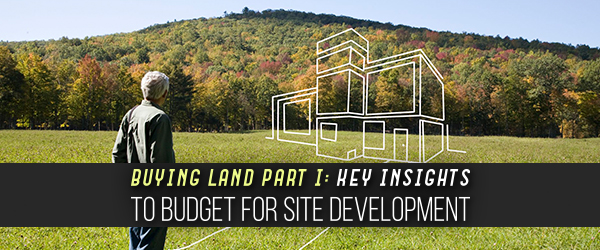When searching for a lot, or piece of land, you make initially find the ideal spot: remote area, scenic vibes, close to nature and a community. What many site-developers don’t anticipate, however, are the unexpected, sometimes unpleasant costs associated with land improvement after closing a deal. Even developers who purchase large land tracts with the hopes of profiting off subdivision often budget more for building and home development costs than the realistic prices associated with buying land.
Many such real estate developers have learned a hard lesson: land development costs can quickly increase. While the ratio varies for the buyer of a single lot at retail pricing, thorough evaluation, and realistic estimates are crucial to the success of your development project.
In this two-part article, we will address the many cost factors associated with site development, and provide key insights to help prospective buyers budget efficiently.
Understanding Cost Factors for Site Development
The costs associated with site development and improvement can be inconsistent; prices can vary dramatically from parcel to parcel even on the same tract of land. There are a considerable number of factors that can affect and increase the costs of site development that every home builder, contractor, and consumers should consider.
Often, site appraisals, soil studies, and other site reviews can uncover potential hazards. However, every home builder and real estate development contractor needs to be prepared for unexpected surprises. For example, seemingly clean soil may turn out to be contaminated or drainage issues may be more severe than initially thought. Such developments could raise the total site development costs.
Not every cost factor is nature-made. Local fees and permitting costs can also affect the final cost of site development. If properly accounted for these fees are relatively easy to predict and manage. However, some families have bought that dream piece of land where they could build their custom home only to find out that they don’t have the money to pay the fees. The same can happen in every other real estate development niche, not just home building.
Utility Lines Can Add Up Quickly
You want that rustic cabin tucked away in the woods. A perfect custom home! Just remember, the further you are from utility lines, the more you will have to pay to install electrical, septic, and other utility systems. While costs range between $50 to $100 per foot, it’s important to check with local home builders and utility authorities to confirm an estimate for installation.
Consider Gradients and Associated Costs
The lay of the land can have a big impact on the development costs on that land, quite literally. For example, a site with a steep incline will usually have additional costs associated. Installing septic systems and your custom home’s foundation may be more expensive.
The Earth Itself Can Impact Development Costs
When it comes to building a custom home or other real estate project, the soil condition can have a tremendous impact on the cost of construction. For example, elevation discrepancies and flood-prone demographics may not support the desired structure. As a result, the home builder may have to budget for resurfacing the soil for development or for adding additional fill material due to the higher elevation of the home.
Don’t Treat Brownfield and Greenfield as the Same
Brownfield land refers to land where a previous development is no longer in use or becomes issued for demolition. Greenfield land is undeveloped. Often, you can pick up brownfield land at a discount in comparison to comparable greenfield land. However, demolishing existing structures and repurposing a property can get very pricey.
Don’t Forget the Local Government
Let’s perform a quick thought experiment. That piece of land tucked in by the river is the perfect spot for a custom home, and it’s listed for a great price! In a rush, you buy the land without asking too many questions. Then, you contact a home builder and send them the blueprints for your dream home.
Only, you find out that you can’t develop that home. Perhaps the house needs to be a certain distance from the river, or building requires you to pay an impact fee. These can range from $1,000 to up to $20,000. Likewise, you might have to pay impact fees to for road usage, fire service, parks, libraries, sewer and water stations, or various other reasons.
Key Take Away: Make Sure You Understand Costs
So what’s the point of all this? Don’t underestimate the costs of site development. Quite frankly, many would-be home builders do so. Make sure you address the regulations drawn from the local government, contractors, and real estate development experts. On top of studying the potential land you’re interested in buying, getting an accurate appraisal and anticipating costs is crucial. Make sure to contact a reputable builder like Belman Homes before purchasing the lot to properly assess the site improvement fees.









